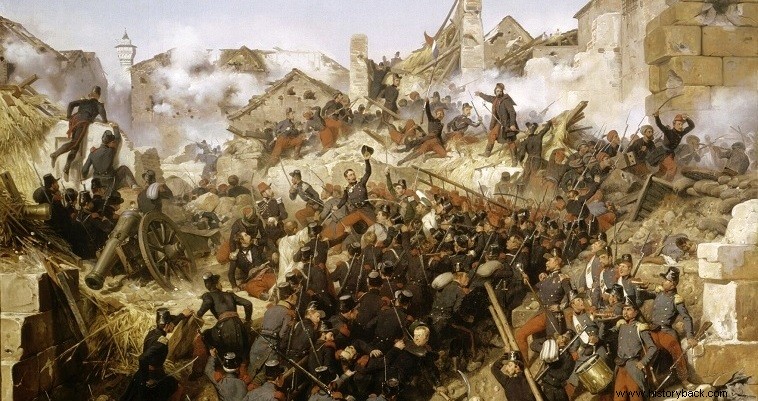
The first Foreign Legion was destroyed in Spain. In 1836 the first divisions of the new legion set foot on African soil again. The new legion had an initial strength of 1,600 men. Major Bento was appointed its commander. The main opponent of the French was the bey of Constantine. Against the city of the same name, the French had attacked in 1836 and had been crushed, suffering losses of 8,000 men.
The new military commander of Algeria, however, General de Damremont, was better prepared and on October 1, 1837, led 20,400 men against Constantine. Among them there were also two battalions of legionnaires. The operations to evacuate the walled city would also be supported by an engineer battalion and 17 heavy guns.
Constantine was very difficult to master. Built on a plateau, which was separated by a wide ravine, which acted as a natural moat from the surrounding hills. There was only one road, which through a bridge led into the city. The French fired their guns at the end of the narrow bridge, 400 meters from the town, and began shelling the walls.
On October 7, the Arabs attacked the French artillery, but were repulsed. Two days later they attacked the pioneer battalion, which was working under the protection of two companies of legionnaires. The attack was decisively repulsed by the legionnaires, who won the credit of the command. In the meantime, the pioneers had built other positions in which the rest of the cannons were placed.
From there, the French artillery managed to slowly neutralize the Algerian guns, located on the walls. After this success, the French artillery concentrated its fire on the walls, with the aim of breaching them. On October 12 the French leader, General Dameron was cut to pieces by an enemy shell.
Valle's replacement stubbornly continued the match. By the next day, the artillery had managed to open a breach in the walls about 20 meters long. The French then saw fit to demand the surrender of the besieged. The latter answered haughtily. "If the Christians have no gunpowder we will send them, if they have no food we will share ours with them, but as long as one of us remains alive, Constantine will not be taken."
A raid against the walls
Despite their haughty response, however, the besieged did not seem to react vigorously to the French advances. They did not attempt to repair the breach. So the French decided to attack. In the first echelon 300 Zouaves, two companies of selectmen of the 2nd Regiment of Light Infantry and 40 pioneers, under Lieutenant-Colonel Lamorissiere poured forward, under the cover of the artillery. In a second echelon, parts of the Legion would attack.
The first echelon of the assault poured with yaks towards the breach, crossed it and entered the city, only to find its way barred by a new wall which the Arabs had secretly constructed. The 600 or so Frenchmen found themselves in an extremely critical situation, receiving fire from all sides. Suddenly a tremendous explosion rocked the area.
The Arabs had dug in the space between the breach and the new wall and had placed barrels of gunpowder, which they blew up! Dozens of French soldiers were literally wasted and those who survived, half-burnt, fled. At that moment, however, the second stage of the attack had begun. With renewed vigor the legionnaires, equipped with sacks of gunpowder, ladders and ropes, drew up, blew up the new wall, passed through the breach and stormed the city.
In the city
The lieutenant of the Legion Saint Arnaud was put in charge of the troops and advanced deep, clearing all resistance. “Our bayonets left no one alive. They were not taking prisoners", he later confessed. Despite the invasion, however, the Arabs did not mean to surrender. They fought from every house, from every cover.
Suddenly the French troops arrived in front of a large stone building from which they received a volley of fire. The French were pinned down. Saint Arnaud, together with four other officers from other regiments, managed to collect a large number of wandering men, whom they led against the building, which turned out to house the barracks of Ahmed Bey, the city guard.
Lieutenant-Colonel Cobb was put in charge, and with sword in hand he charged. A projectile hit him but he kept walking. A second hit him and fell mortally wounded. However, the men, led by Saint Arnaud, followed his example and managed to take over the barracks, after a deadly fight. “Blood was flowing on the steps. Not a cry, not a complaint escaped the lips of the dying men," said Saint Arnaud .
The violence of the fight lasted only a few minutes. Gradually the Arabs began to surrender. On the other side of the city, however, a large part of the civilian population tried to escape through the flaps and ravines that surrounded the city. Hundreds perished in the desperate attempt. Few escaped. The others surrendered.
In the meantime the rest of the French troops had entered the city, and an orgy of plunder and pillage began, as usually happened in cases of violent capture of cities. Only the gunpowder-smoked legionnaires did not, except in isolated cases, participate in the orgy of violence. The Legion had not particularly distinguished itself in battle. Of the 100 men that Saint Arnaud led in the first phase of the battle, 10 were killed and 11 wounded.
One of the dead, the legionnaire Keller, saved Saint Arnaud's life. In one phase of the street fighting, Saint Arnaud and his legionnaires found themselves in front of a group of Turkish soldiers of the Algerine bey. In a fraction of a second, Keller stood in front of Saint Arnaud and received the enemy's thunder!
